Distributed Energy Resources Management System (DERMS) and Its Coordination with Transmission System: A Review and Co-Simulation
Abstract
:1. Introduction
2. Literature Review
2.1. Distributed Energy Resources Management System
2.2. Hardware-in-the-Loop
2.3. Energy Management
2.4. Simultaneous Study of Transmission and Distribution Grids
3. Proposed Method
4. Results and Discussion
4.1. Case Study 1
4.2. Case Study 2
5. Conclusions
Author Contributions
Funding
Data Availability Statement
Conflicts of Interest
References
- Asimakopoulou, G.E.; Hatziargyriou, N.D. Evaluation of economic benefits of DER aggregation. IEEE Trans. Sustain. Energy 2017, 9, 499–510. [Google Scholar] [CrossRef]
- Hu, J.; Shan, Y.; Cheng, K.W.; Islam, S. Overview of power converter control in microgrids—Challenges, advances, and future trends. IEEE Trans. Power Electron. 2022, 37, 9907–9922. [Google Scholar] [CrossRef]
- Parhizi, S.; Lotfi, H.; Khodaei, A.; Bahramirad, S. State of the art in research on microgrids: A review. IEEE Access 2015, 3, 890–925. [Google Scholar] [CrossRef]
- Najafzadeh, M.; Ahmadiahangar, R.; Husev, O.; Roasto, I.; Jalakas, T.; Blinov, A. Recent contributions, future prospects and limitations of interlinking converter control in hybrid AC/DC microgrids. IEEE Access 2021, 9, 7960–7984. [Google Scholar] [CrossRef]
- Peyghami, S.; Palensky, P.; Blaabjerg, F. An overview on the reliability of modern power electronic based power systems. IEEE Open J. Power Electron. 2020, 1, 34–50. [Google Scholar] [CrossRef]
- Martins, V.F.; Borges, C.L. Active distribution network integrated planning incorporating distributed generation and load response uncertainties. IEEE Trans. Power Syst. 2011, 26, 2164–2172. [Google Scholar] [CrossRef]
- Mokryani, G.; Hu, Y.F.; Papadopoulos, P.; Niknam, T.; Aghaei, J. Deterministic approach for active distribution networks planning with high penetration of wind and solar power. Renew. Energy 2017, 113, 942–951. [Google Scholar] [CrossRef]
- Mokryani, G.; Hu, Y.F.; Pillai, P.; Rajamani, H.-S. Active distribution networks planning with high penetration of wind power. Renew. Energy 2017, 104, 40–49. [Google Scholar] [CrossRef]
- Sajadi, A.; Strezoski, L.; Clark, K.; Prica, M.; Loparo, K. Transmission system protection screening for integration of offshore wind power plants. Renew. Energy 2018, 125, 225–233. [Google Scholar] [CrossRef]
- Tang, Z.; Hill, D.J.; Liu, T. Distributed coordinated reactive power control for voltage regulation in distribution networks. IEEE Trans. Smart Grid 2020, 12, 312–323. [Google Scholar] [CrossRef]
- Bedawy, A.; Yorino, N.; Mahmoud, K.; Zoka, Y.; Sasaki, Y. Optimal voltage control strategy for voltage regulators in active unbalanced distribution systems using multi-agents. IEEE Trans. Power Syst. 2019, 35, 1023–1035. [Google Scholar] [CrossRef]
- Cao, D.; Zhao, J.; Hu, W.; Yu, N.; Ding, F.; Huang, Q.; Chen, Z. Deep reinforcement learning enabled physical-model-free two-timescale voltage control method for active distribution systems. IEEE Trans. Smart Grid 2021, 13, 149–165. [Google Scholar] [CrossRef]
- Garcia-Munoz, F.; Diaz-Gonzalez, F.; Corchero, C. A two-stage stochastic programming model for the sizing and location of DERs considering electric vehicles and demand response. Sustain. Energy Grids Netw. 2022, 30, 100624. [Google Scholar] [CrossRef]
- Pourghasem, P.; Sohrabi, F.; Abapour, M.; Mohammadi-Ivatloo, B. Stochastic multi-objective dynamic dispatch of renewable and CHP-based islanded microgrids. Electr. Power Syst. Res. 2019, 173, 193–201. [Google Scholar] [CrossRef]
- Wang, S.; Zhao, C.; Fan, L.; Bo, R. Distributionally robust unit commitment with flexible generation resources considering renewable energy uncertainty. IEEE Trans. Power Syst. 2022, 37, 4179–4190. [Google Scholar] [CrossRef]
- Pourghasem, P.; Seyedi, H.; Zare, K. A new optimal under-voltage load shedding scheme for voltage collapse prevention in a multi-microgrid system. Electr. Power Syst. Res. 2022, 203, 107629. [Google Scholar] [CrossRef]
- Fang, Y.; Jia, K.; Yang, Z.; Li, Y.; Bi, T. Impact of inverter-interfaced renewable energy generators on distance protection and an improved scheme. IEEE Trans. Ind. Electron. 2018, 66, 7078–7088. [Google Scholar] [CrossRef]
- Jia, K.; Yang, Z.; Fang, Y.; Bi, T.; Sumner, M. Influence of inverter-interfaced renewable energy generators on directional relay and an improved scheme. IEEE Trans. Power Electron. 2019, 34, 11843–11855. [Google Scholar] [CrossRef]
- Chao, C.; Zheng, X.; Weng, Y.; Liu, Y.; Gao, P.; Tai, N. Adaptive distance protection based on the analytical model of additional impedance for inverter-interfaced renewable power plants during asymmetrical faults. IEEE Trans. Power Deliv. 2021, 37, 3823–3834. [Google Scholar] [CrossRef]
- Strezoski, L. Distributed energy resource management systems—DERMS: State of the art and how to move forward. Wiley Interdiscip. Rev. Energy Environ. 2023, 12, e460. [Google Scholar] [CrossRef]
- Kramer, W.; Chakraborty, S.; Kroposki, B.; Thomas, H. Advanced Power Electronic Interfaces for Distributed Energy Systems Part 1: Systems and Topologies; National Renewable Energy Lab. (NREL): Golden, CO, USA, 2008.
- Ivanović, Z.R.; Adžić, E.M.; Vekić, M.S.; Grabić, S.U.; Čelanović, N.L.; Katić, V.A. HIL evaluation of power flow control strategies for energy storage connected to smart grid under unbalanced conditions. IEEE Trans. Power Electron. 2012, 27, 4699–4710. [Google Scholar] [CrossRef]
- IEEE. 2030.11-2021-IEEE Guide for Distributed Energy Resources Management Systems (DERMS) Functional Specification; IEEE: New York, NY, USA, 2021; pp. 1–61. [Google Scholar] [CrossRef]
- Strezoski, L.; Padullaparti, H.; Ding, F.; Baggu, M. Integration of utility distributed energy resource management system and aggregators for evolving distribution system operators. J. Mod. Power Syst. Clean Energy 2022, 10, 277–285. [Google Scholar] [CrossRef]
- Strezoski, L.; Stefani, I. Utility DERMS for active management of emerging distribution grids with high penetration of renewable DERs. Electronics 2021, 10, 2027. [Google Scholar] [CrossRef]
- Strezoski, L.; Stefani, I.; Brbaklic, B. Active management of distribution systems with high penetration of distributed energy resources. In Proceedings of the IEEE EUROCON 2019-18th International Conference on Smart Technologies, Novi Sad, Serbia, 1–4 July 2019; pp. 1–5. [Google Scholar]
- Petrovic, N.; Strezoski, L.; Dumnic, B. Overview of software tools for integration and active management of high penetration of DERs in emerging distribution networks. In Proceedings of the IEEE EUROCON 2019-18th International Conference on Smart Technologies, Novi Sad, Serbia, 1–4 July 2019; pp. 1–6. [Google Scholar]
- Strezoski, L. Utility DERMS and DER Aggregators: An Ideal Case for Tomorrow’s DSO. In Proceedings of the 2022 IEEE PES Innovative Smart Grid Technologies Conference Europe (ISGT-Europe), Novi Sad, Serbia, 10–12 October 2022; pp. 1–5. [Google Scholar]
- Horowitz, K.A.; Jain, A.; Ding, F.; Mather, B.; Palmintier, B. A techno-economic comparison of traditional upgrades, volt-var controls, and coordinated distributed energy resource management systems for integration of distributed photovoltaic resources. Int. J. Electr. Power Energy Syst. 2020, 123, 106222. [Google Scholar] [CrossRef]
- Ilic, M.D.; Jaddivada, R.; Korpas, M. Interactive protocols for distributed energy resource management systems (DERMS). IET Gener. Transm. Distrib. 2020, 14, 2065–2081. [Google Scholar] [CrossRef]
- Rahman, I.; Selak, N.; Paaso, E. Distributed energy resource management system (DERMS) solution for feeder voltage management for utility integrated DERs. In Proceedings of the 2021 IEEE Power & Energy Society Innovative Smart Grid Technologies Conference (ISGT), Washington, DC, USA, 16–18 February 2021; pp. 1–5. [Google Scholar]
- Iqbal, A.; Aoki, Y.; Ninagawa, C.; Murakawa, T. DERMS Volt-Var Control of a Power Distribution System Using Clusters of Building Multi-type Air-conditioners. IEEJ Trans. Power Energy 2023, 143, 34–41. [Google Scholar] [CrossRef]
- Machado, L.F.M.; Di Santo, S.G.; Junior, G.M.; Itiki, R.; Manjrekar, M.D. Multi-source distributed energy resources management system based on pattern search optimal solution using nonlinearized power flow constraints. IEEE Access 2021, 9, 30374–30385. [Google Scholar] [CrossRef]
- Bilakanti, N.; Gurung, N.; Chen, H.; Kothandaraman, S.R. Priority-based management algorithm in distributed energy resource management systems. In Proceedings of the 2021 IEEE Green Technologies Conference (GreenTech), Denver, CO, USA, 7–9 April 2021; pp. 351–356. [Google Scholar]
- Liu, F.; Chen, C.; Lin, C.; Li, G.; Xie, H.; Bie, Z. Utilizing Aggregated Distributed Renewable Energy Sources with Control Coordination for Resilient Distribution System Restoration. IEEE Trans. Sustain. Energy 2023, 14, 1043–1056. [Google Scholar] [CrossRef]
- Wang, J.; Simpson, J.; Yang, R.; Palmintier, B.; Tiwari, S.; Zhang, Y. Hardware-in-the-loop evaluation of an advanced distributed energy resource management algorithm. In Proceedings of the 2021 IEEE Power & Energy Society Innovative Smart Grid Technologies Conference (ISGT), Washington, DC, USA, 16–18 February 2021; pp. 1–5. [Google Scholar]
- Nowak, S.; Tehrani, N.; Metcalfe, M.S.; Eberle, W.; Wang, L. Cloud-based DERMS test platform using real-time power system simulation. In Proceedings of the 2018 IEEE Power & Energy Society General Meeting (PESGM), Portland, OR, USA, 5–10 August 2018; pp. 1–5. [Google Scholar]
- Wang, J.; Simpson, J.; Yang, R.; Palmintier, B.; Tiwari, S.; Zhang, Y. Performance Evaluation of an Advanced Distributed Energy Resource Management Algorithm. In Proceedings of the 2021 IEEE International Conference on Communications, Control, and Computing Technologies for Smart Grids (SmartGridComm), Aachen, Germany, 25–28 October 2021; pp. 378–384. [Google Scholar]
- Wang., J. Performance evaluation of distributed energy resource management via advanced hardware-in-the-loop simulation. In Proceedings of the 2020 IEEE Power & Energy Society Innovative Smart Grid Technologies Conference (ISGT), Washington, DC, USA, 17–20 February 2020; pp. 1–5. [Google Scholar]
- Wang, J.; Padullaparti, H.; Veda, S.; Mendoza, I.; Tiwari, S.; Baggu, M. Performance evaluation of data-enhanced hierarchical control for grid operations. In Proceedings of the 2020 IEEE Power & Energy Society General Meeting (PESGM), Montreal, QC, Canada, 2–6 August 2020; pp. 1–5. [Google Scholar]
- Poudel, S.; Keene, S.J.; Kini, R.L.; Hanif, S.; Bass, R.B.; Kolln, J.T. Modeling Environment for Testing a Distributed Energy Resource Management System (DERMS) Using GridAPPS-D Platform. IEEE Access 2022, 10, 77383–77395. [Google Scholar] [CrossRef]
- Melton, R.B.; Schneider, K.P.; Lightner, E.; Mcdermott, T.E.; Sharma, P.; Zhang, Y.; Ding, F.; Vadari, S.; Podmore, R.; Dubey, A.; et al. Leveraging standards to create an open platform for the development of advanced distribution applications. IEEE Access 2018, 6, 37361–37370. [Google Scholar] [CrossRef]
- Wang, J.; Padullaparti, H.; Ding, F.; Baggu, M.; Symko-Davies, M. Voltage regulation performance evaluation of distributed energy resource management via advanced hardware-in-the-loop simulation. Energies 2021, 14, 6734. [Google Scholar] [CrossRef]
- Kim, J.; Park, K.; Ahn, B.; Choi, J.; Noh, Y.; Won, D.; Kim, T. Real-time hardware-in-the-loop distributed energy resources system testbed using IEEE 2030.5 standard. In Proceedings of the 2021 IEEE PES Innovative Smart Grid Technologies-Asia (ISGT Asia), Brisbane, Australia, 5–8 December 2021; pp. 1–5. [Google Scholar]
- Salehi, N.; Martínez-García, H.; Velasco-Quesada, G.; Guerrero, J.M. A comprehensive review of control strategies and optimization methods for individual and community microgrids. IEEE Access 2022, 10, 15935–15955. [Google Scholar] [CrossRef]
- Wang, Z.; Chen, B.; Wang, J.; Begovic, M.M.; Chen, C. Coordinated energy management of networked microgrids in distribution systems. IEEE Trans. Smart Grid 2014, 6, 45–53. [Google Scholar] [CrossRef]
- Jadhav, A.M.; Zheng, Y.; Suryanarayanan, S.; Patne, N.R. Energy management in multi-microgrid system with community battery energy storage. In Proceedings of the 2018 20th National Power Systems Conference (NPSC), Tiruchirappalli, India, 14–16 December 2018; pp. 1–6. [Google Scholar]
- Lu, T.; Wang, Z.; Ai, Q.; Lee, W.-J. Interactive model for energy management of clustered microgrids. IEEE Trans. Ind. Appl. 2017, 53, 1739–1750. [Google Scholar] [CrossRef]
- Yang, X.; Song, Z.; Wen, J.; Ding, L.; Zhang, M.; Wu, Q.; Cheng, S. Network-Constrained Transactive Control for Multi-Microgrids-based Distribution Networks with Soft Open Points. IEEE Trans. Sustain. Energy 2023, 14, 1769–1783. [Google Scholar] [CrossRef]
- Van der Meer, D.; Mouli, G.R.C.; Mouli, G.M.-E.; Elizondo, L.R.; Bauer, P. Energy management system with PV power forecast to optimally charge EVs at the workplace. IEEE Trans. Ind. Inform. 2016, 14, 311–320. [Google Scholar] [CrossRef]
- Shuvra, M.A.; Chowdhury, B. Load management system and control strategies of distributed energy resources in an islanded microgrid. In Proceedings of the 2019 IEEE 16th International Conference on Smart Cities: Improving Quality of Life Using ICT & IoT and AI (HONET-ICT), Charlotte, NC, USA, 6–9 October 2019; pp. 100–104. [Google Scholar]
- Ding, L.; Yin, G.Y.; Zheng, W.X.; Han, Q.-L. Distributed energy management for smart grids with an event-triggered communication scheme. IEEE Trans. Control. Syst. Technol. 2018, 27, 1950–1961. [Google Scholar] [CrossRef]
- Mohseni-Bonab, S.M.; Hajebrahimi, A.; Kamwa, I.; Moeini, A. Transmission and distribution co-simulation: A review and propositions. IET Gener. Transm. Distrib. 2020, 14, 4631–4642. [Google Scholar] [CrossRef]
- Wang, W.; Fang, X.; Cui, H.; Li, F.; Liu, Y.; Overbye, T.J. Transmission-and-distribution dynamic co-simulation framework for distributed energy resource frequency response. IEEE Trans. Smart Grid 2021, 13, 482–495. [Google Scholar] [CrossRef]
- Wang, Y.; Wu, H.; Xu, H.; Li, Q.; Liu, S. A general fast power flow algorithm for transmission and distribution networks. IEEE Access 2020, 8, 23284–23293. [Google Scholar] [CrossRef]
- Zhu, X.; Wang, J.; Lu, N.; Samaan, N.; Huang, R.; Ke, X. A hierarchical vlsm-based demand response strategy for coordinative voltage control between transmission and distribution systems. IEEE Trans. Smart Grid 2018, 10, 4838–4847. [Google Scholar] [CrossRef]
- Lin, C.; Wu, W.; Shahidehpour, M.; Guo, Y.; Wang, B. A non-iterative decoupled solution of the coordinated robust OPF in transmission and distribution networks with variable generating units. IEEE Trans. Sustain. Energy 2019, 11, 1579–1588. [Google Scholar] [CrossRef]
- Tang, K.; Dong, S.; Song, Y. A Quadratic Convergent Iteration-Variable-Correction-Based Method for Optimal Power Flow of Transmission-Distribution-Coupled Systems. IEEE Syst. J. 2021, 16, 3360–3371. [Google Scholar] [CrossRef]
- Tang, K.; Dong, S.; Song, Y. An Asynchronous Forward-Backward-Splitting Power Flow Algorithm of Coupled Transmission and Active Distribution Systems. IEEE Trans. Smart Grid 2021, 12, 5457–5471. [Google Scholar] [CrossRef]
- Li, Z.; Guo, Q.; Sun, H.; Wang, J. Coordinated transmission and distribution AC optimal power flow. IEEE Trans. Smart Grid 2016, 9, 1228–1240. [Google Scholar] [CrossRef]
- Lin, C.; Wu, W.; Shahidehpour, M. Decentralized AC optimal power flow for integrated transmission and distribution grids. IEEE Trans. Smart Grid 2019, 11, 2531–2540. [Google Scholar] [CrossRef]
- Ranamuka, D.; Muttaqi, K.M.; Sutanto, D. Flexible AC power flow control in distribution systems by coordinated control of distributed solar-PV and battery energy storage units. IEEE Trans. Sustain. Energy 2019, 11, 2054–2062. [Google Scholar] [CrossRef]
- Huang, Q.; Vittal, V. Integrated Transmission and Distribution System Power Flow and Dynamic Simulation Using Mixed Three-Sequence/Three-Phase Modeling. IEEE Trans. Power Syst. 2017, 32, 3704–3714. [Google Scholar] [CrossRef]
- Sun, H.; Guo, Q.; Zhang, B.; Guo, Y.; Li, Z.; Wang, J. Master–Slave-Splitting Based Distributed Global Power Flow Method for Integrated Transmission and Distribution Analysis. IEEE Trans. Smart Grid 2015, 6, 1484–1492. [Google Scholar] [CrossRef]
- Li, Z.; Wang, J.; Sun, H.; Guo, Q. Transmission Contingency Analysis Based on Integrated Transmission and Distribution Power Flow in Smart Grid. IEEE Trans. Power Syst. 2015, 30, 3356–3367. [Google Scholar] [CrossRef]
- Li, Z.; Guo, Q.; Sun, H.; Wang, J. Coordinated economic dispatch of coupled transmission and distribution systems using heterogeneous decomposition. IEEE Trans. Power Syst. 2016, 31, 4817–4830. [Google Scholar] [CrossRef]
- Lin, C.; Wu, W.; Chen, X.; Zheng, W. Decentralized dynamic economic dispatch for integrated transmission and active distribution networks using multi-parametric programming. IEEE Trans. Smart Grid 2017, 9, 4983–4993. [Google Scholar] [CrossRef]
- Li, P.; Wu, Q.; Yang, M.; Li, Z.; Hatziargyriou, N.D. Distributed distributionally robust dispatch for integrated transmission-distribution systems. IEEE Trans. Power Syst. 2020, 36, 1193–1205. [Google Scholar] [CrossRef]
- Zhou, X.; Chang, C.-Y.; Bernstein, A.; Zhao, C.; Chen, L. Economic Dispatch with Distributed Energy Resources: Co-Optimization of Transmission and Distribution Systems. IEEE Control Syst. Lett. 2020, 5, 1994–1999. [Google Scholar] [CrossRef]
- Fan, G.; Lin, S.; Feng, X.; Wang, Q.; Liu, M. Stochastic Economic Dispatch of Integrated Transmission and Distribution Networks Using Distributed Approximate Dynamic Programming. IEEE Syst. J. 2022, 16, 5985–5996. [Google Scholar] [CrossRef]
- Zhao, J.; Wang, H.; Liu, Y.; Wu, Q.; Wang, Z.; Liu, Y. Coordinated restoration of transmission and distribution system using decentralized scheme. IEEE Trans. Power Syst. 2019, 34, 3428–3442. [Google Scholar] [CrossRef]
- Sun, W.; Golshani, A. Distributed restoration for integrated transmission and distribution systems with DERs. IEEE Trans. Power Syst. 2019, 34, 4964–4973. [Google Scholar]
- Chen, Z.; Li, Z.; Guo, C.; Wang, J.; Ding, Y. Fully distributed robust reserve scheduling for coupled transmission and distribution systems. IEEE Trans. Power Syst. 2020, 36, 169–182. [Google Scholar] [CrossRef]
- Jia, H.; Qi, W.; Liu, Z.; Wang, B.; Zeng, Y.; Xu, T. Hierarchical risk assessment of transmission system considering the influence of active distribution network. IEEE Trans. Power Syst. 2014, 30, 1084–1093. [Google Scholar] [CrossRef]
- Li, Z.; Guo, Q.; Sun, H.; Wang, J. Impact of Coupled Transmission-Distribution on Static Voltage Stability Assessment. IEEE Trans. Power Syst. 2017, 32, 3311–3312. [Google Scholar] [CrossRef]
- Li, Z.; Guo, Q.; Sun, H.; Wang, J.; Xu, Y.; Fan, M. A distributed transmission-distribution-coupled static voltage stability assessment method considering distributed generation. IEEE Trans. Power Syst. 2017, 33, 2621–2632. [Google Scholar] [CrossRef]
- Muñoz-Delgado, G.; Contreras, J.; Arroyo, J.M.; Nieta, A.S.D.L.; Gibescu, M. Integrated Transmission and Distribution System Expansion Planning Under Uncertainty. IEEE Trans. Smart Grid 2021, 12, 4113–4125. [Google Scholar] [CrossRef]
- Zhu, X.; Cheng, M.; Zhao, W.; Liu, C.; Chau, K. A transient cosimulation approach to performance analysis of hybrid excited doubly salient machine considering indirect field-circuit coupling. IEEE Trans. Magn. 2007, 43, 2558–2560. [Google Scholar] [CrossRef]
- Li, L.; Fu, W.; Ho, S.L.; Niu, S.; Li, Y. A quantitative comparison study of power-electronic-driven flux-modulated machines using magnetic field and thermal field co-simulation. IEEE Trans. Ind. Electron. 2015, 62, 6076–6084. [Google Scholar] [CrossRef]
- Al-Hammouri, A.T. A comprehensive co-simulation platform for cyber-physical systems. Comput. Commun. 2012, 36, 8–19. [Google Scholar] [CrossRef]
- Zhang, Z.; Eyisi, E.; Koutsoukos, X.; Porter, J.; Karsai, G.; Sztipanovits, J. A co-simulation framework for design of time-triggered automotive cyber physical systems. Simul. Model. Pract. Theory 2014, 43, 16–33. [Google Scholar] [CrossRef]
- Strasser, T.; Stifter, M.; Andrén, F.; Palensky, P. Co-simulation training platform for smart grids. IEEE Trans. Power Syst. 2014, 29, 1989–1997. [Google Scholar] [CrossRef]
- Albagli, A.N.; Falcão, D.M.; de Rezende, J.F. Smart grid framework co-simulation using HLA architecture. Electr. Power Syst. Res. 2016, 130, 22–33. [Google Scholar] [CrossRef]
- Li, X.; Huang, Q.; Wu, D. Distributed large-scale co-simulation for IoT-aided smart grid control. IEEE Access 2017, 5, 19951–19960. [Google Scholar] [CrossRef]
- Vogt, M.; Marten, F.; Braun, M. A survey and statistical analysis of smart grid co-simulations. Appl. Energy 2018, 222, 67–78. [Google Scholar] [CrossRef]
- Trčka, M.; Hensen, J.L.; Wetter, M. Co-simulation of innovative integrated HVAC systems in buildings. J. Build. Perform. Simul. 2009, 2, 209–230. [Google Scholar] [CrossRef]
- Wetter, M. Co-simulation of building energy and control systems with the Building Controls Virtual Test Bed. J. Build. Perform. Simul. 2011, 4, 185–203. [Google Scholar] [CrossRef]
- Rajendhar, P.; Jeyaraj, B.E. Application of DR and co-simulation approach for renewable integrated HEMS: A review. IET Gener. Transm. Distrib. 2019, 13, 3501–3512. [Google Scholar] [CrossRef]
- Garau, M.; Celli, G.; Ghiani, E.; Pilo, F.; Corti, S. Evaluation of smart grid communication technologies with a co-simulation platform. IEEE Wirel. Commun. 2017, 24, 42–49. [Google Scholar] [CrossRef]
- Lin, H.; Veda, S.S.; Shukla, S.S.; Mili, L.; Thorp, J. GECO: Global event-driven co-simulation framework for interconnected power system and communication network. IEEE Trans. Smart Grid 2012, 3, 1444–1456. [Google Scholar] [CrossRef]
- Mana, P.T.; Schneider, K.P.; Du, W.; Mukherjee, M.; Hardy, T.; Tuffner, F.K. Study of microgrid resilience through co-simulation of power system dynamics and communication systems. IEEE Trans. Ind. Inform. 2020, 17, 1905–1915. [Google Scholar] [CrossRef]
- Bhor, D.; Angappan, K.; Sivalingam, K.M. Network and power-grid co-simulation framework for Smart Grid wide-area monitoring networks. J. Netw. Comput. Appl. 2016, 59, 274–284. [Google Scholar] [CrossRef]
- Balasubramaniam, K.; Abhyankar, S. A combined transmission and distribution system co-simulation framework for assessing the impact of volt/var control on transmission system. In Proceedings of the 2017 IEEE Power & Energy Society General Meeting, Chicago, IL, USA, 16–20 July 2017; pp. 1–5. [Google Scholar]
- Velaga, Y.N.; Chen, A.; Sen, P.K.; Krishnamoorthy, G.; Dubey, A. Transmission-Distribution Co-Simulation: Model Validation with Standalone Simulation. In Proceedings of the 2018 North American Power Symposium (NAPS), Fargo, ND, USA, 9–11 September 2018; pp. 1–6. [Google Scholar] [CrossRef]
- Palmintier, B.; Krishnamurthy, D.; Top, P.; Smith, S.; Daily, J.; Fuller, J. Design of the HELICS high-performance transmission-distribution-communication-market co-simulation framework. In Proceedings of the 2017 Workshop on Modeling and Simulation of Cyber-Physical Energy Systems (MSCPES), Pittsburgh, PA, USA, 21 April 2017; pp. 1–6. [Google Scholar] [CrossRef]
- Venkatraman, R.; Khaitan, S.K.; Ajjarapu, V. Dynamic co-simulation methods for combined transmission-distribution system with integration time step impact on convergence. IEEE Trans. Power Syst. 2018, 34, 1171–1181. [Google Scholar] [CrossRef]
- Palmintier, B.; Hale, E.; Hansen, T.M.; Jones, W.; Biagioni, D.; Sorensen, H.; Wu, H.; Hodge, B.-M. IGMS: An integrated ISO-to-appliance scale grid modeling system. IEEE Trans. Smart Grid 2016, 8, 1525–1534. [Google Scholar] [CrossRef]
- Sadnan, R.; Krishnamoorthy, G.; Dubey, A. Transmission and distribution (T&D) quasi-static co-simulation: Analysis and comparison of T&D coupling strength. IEEE Access 2020, 8, 124007–124019. [Google Scholar]


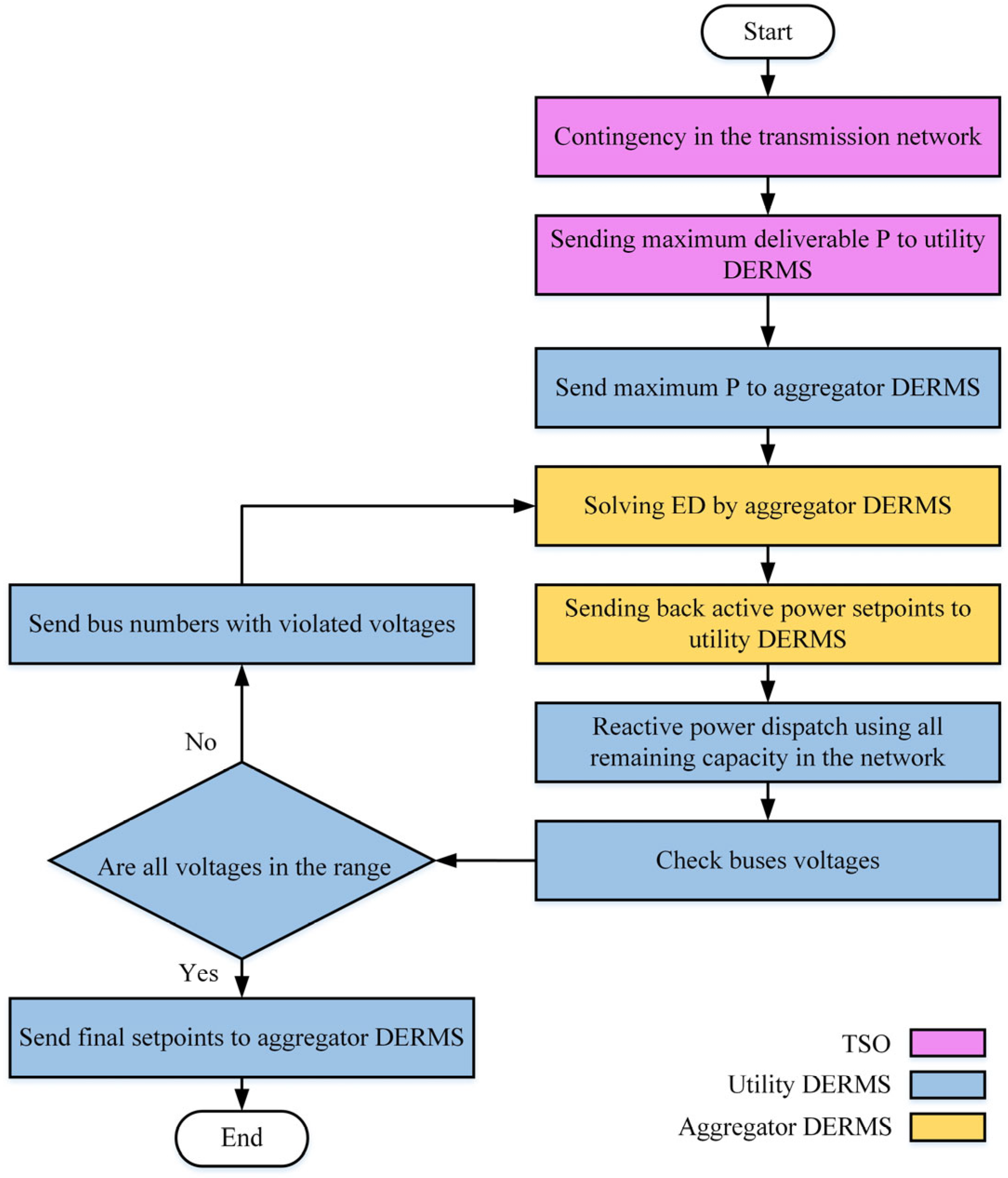
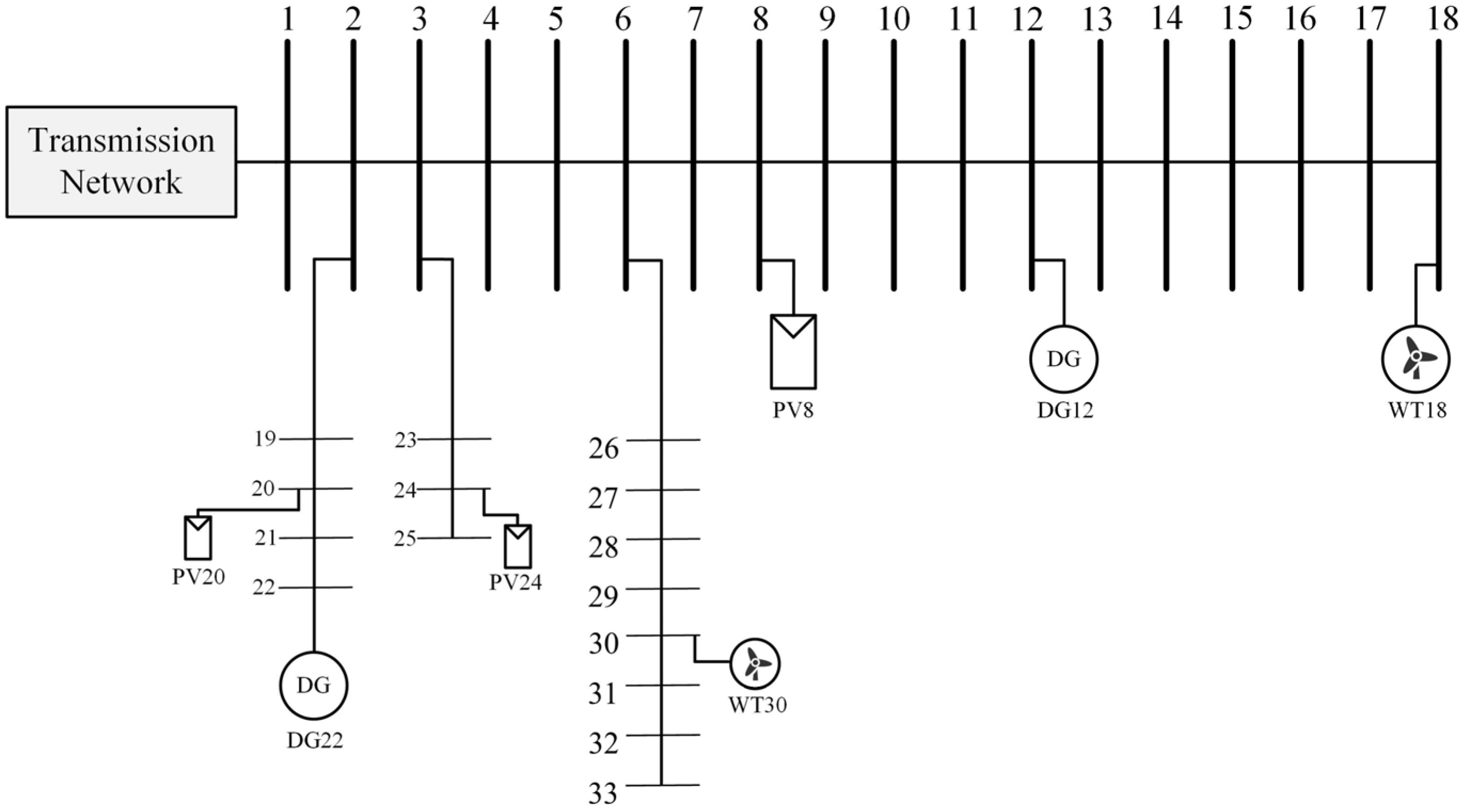
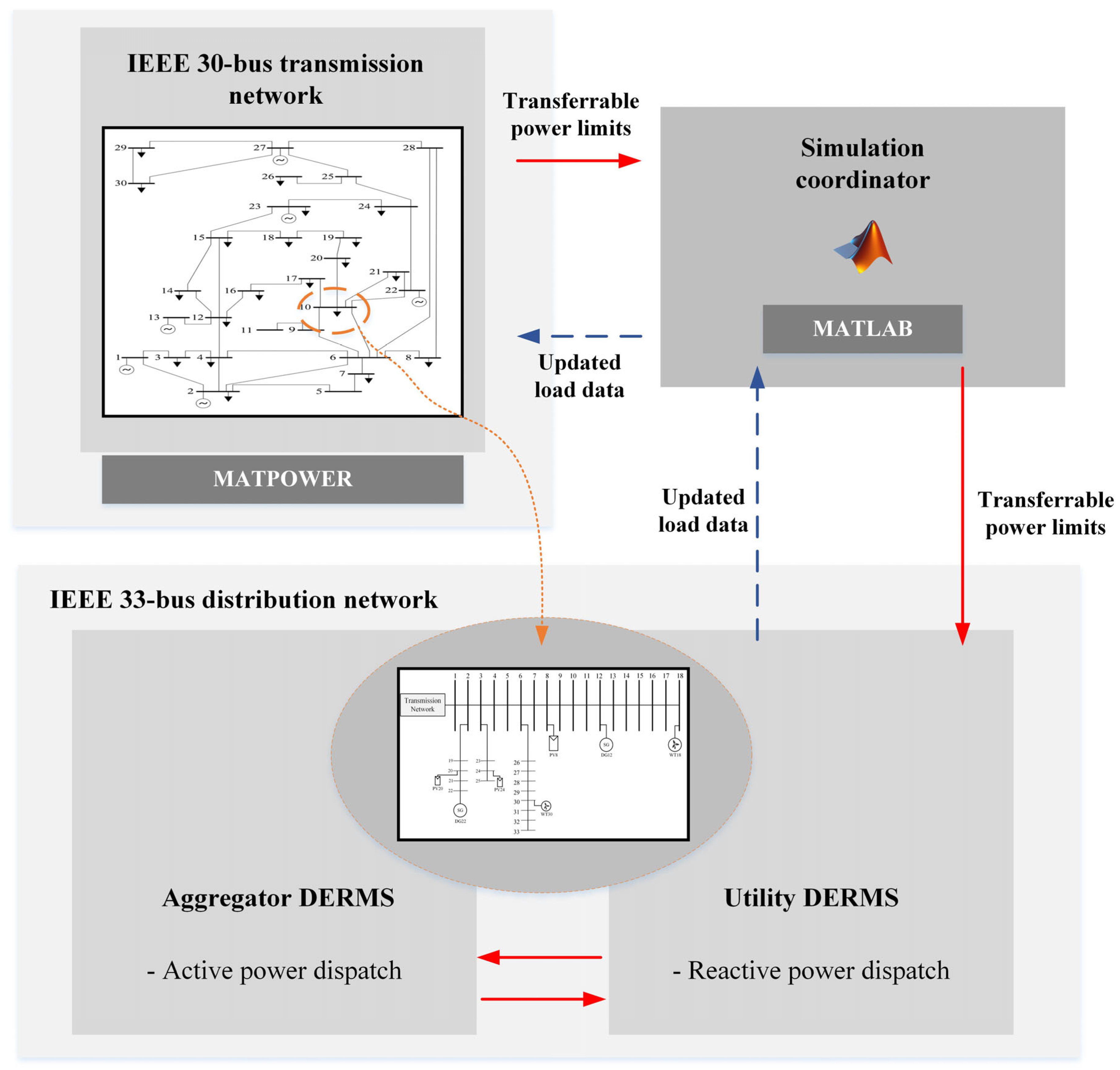
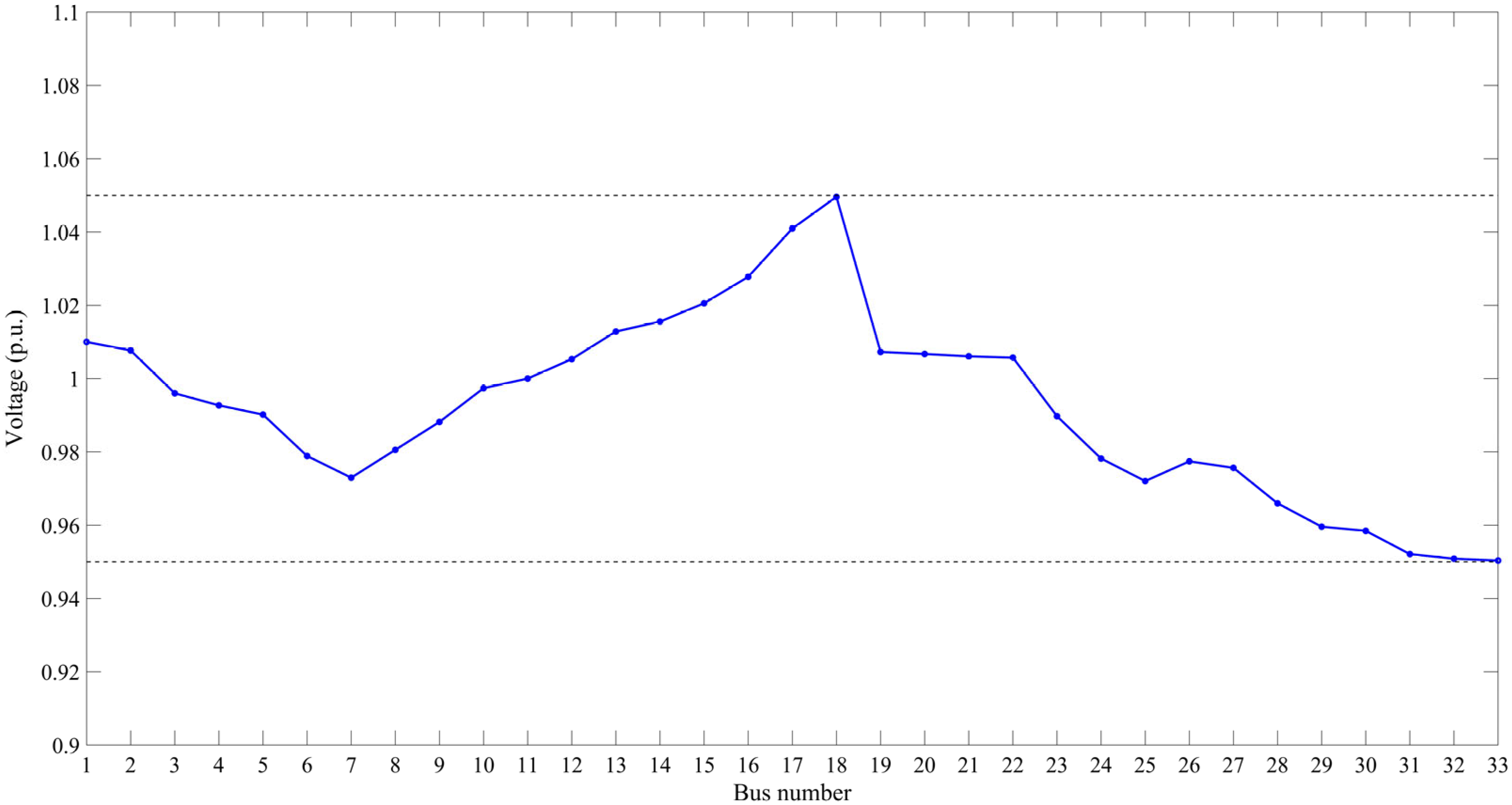
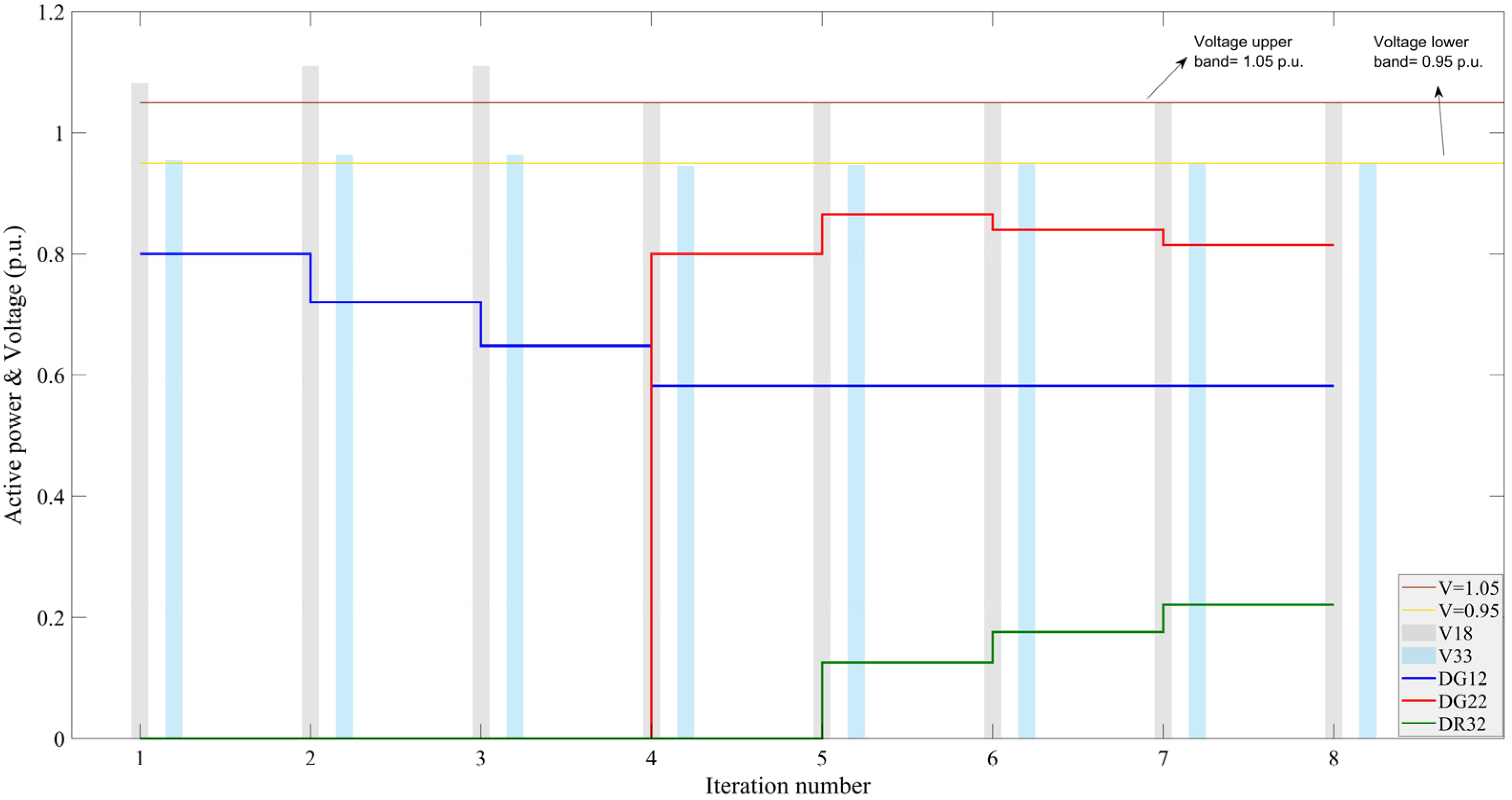
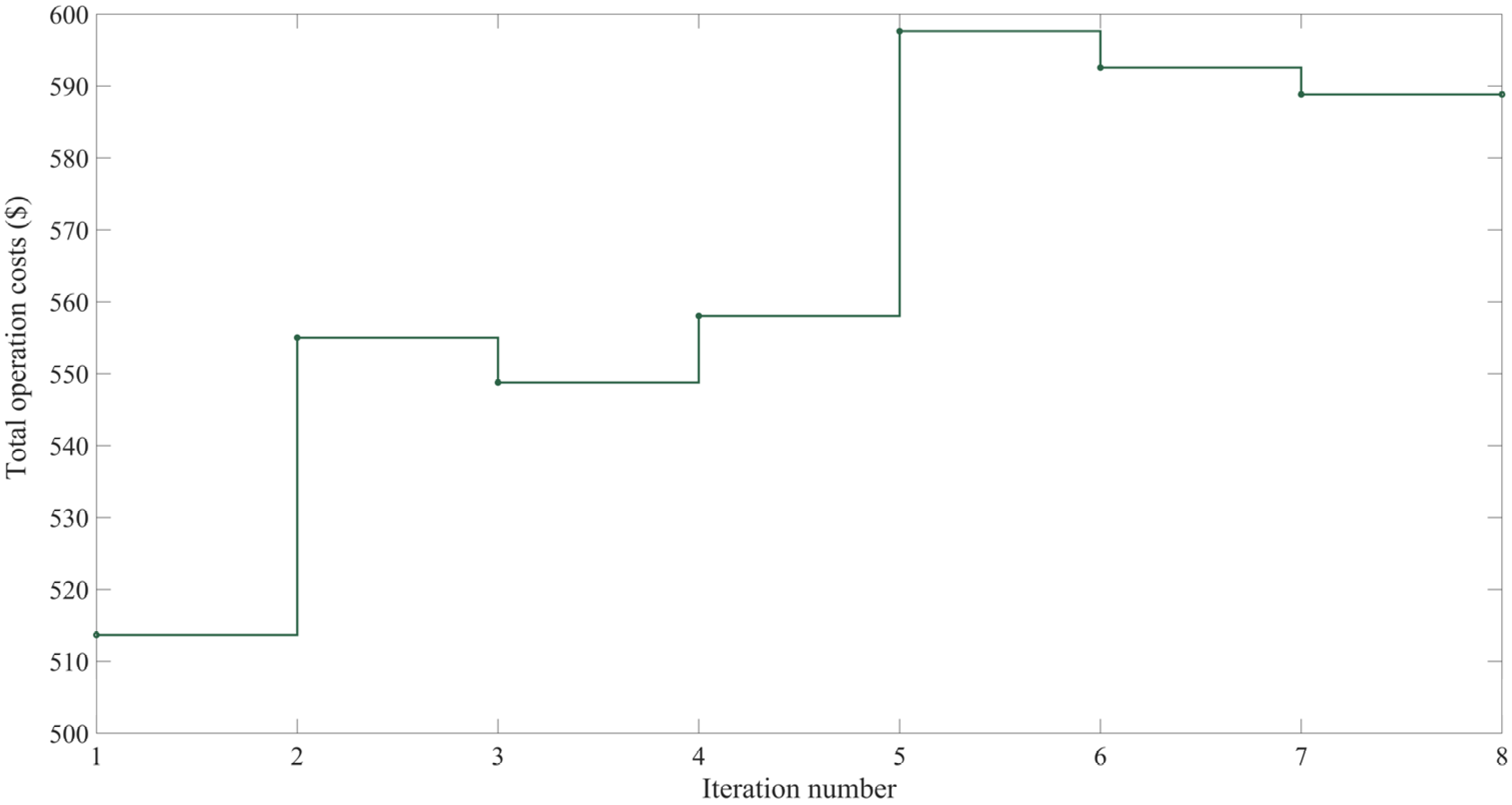
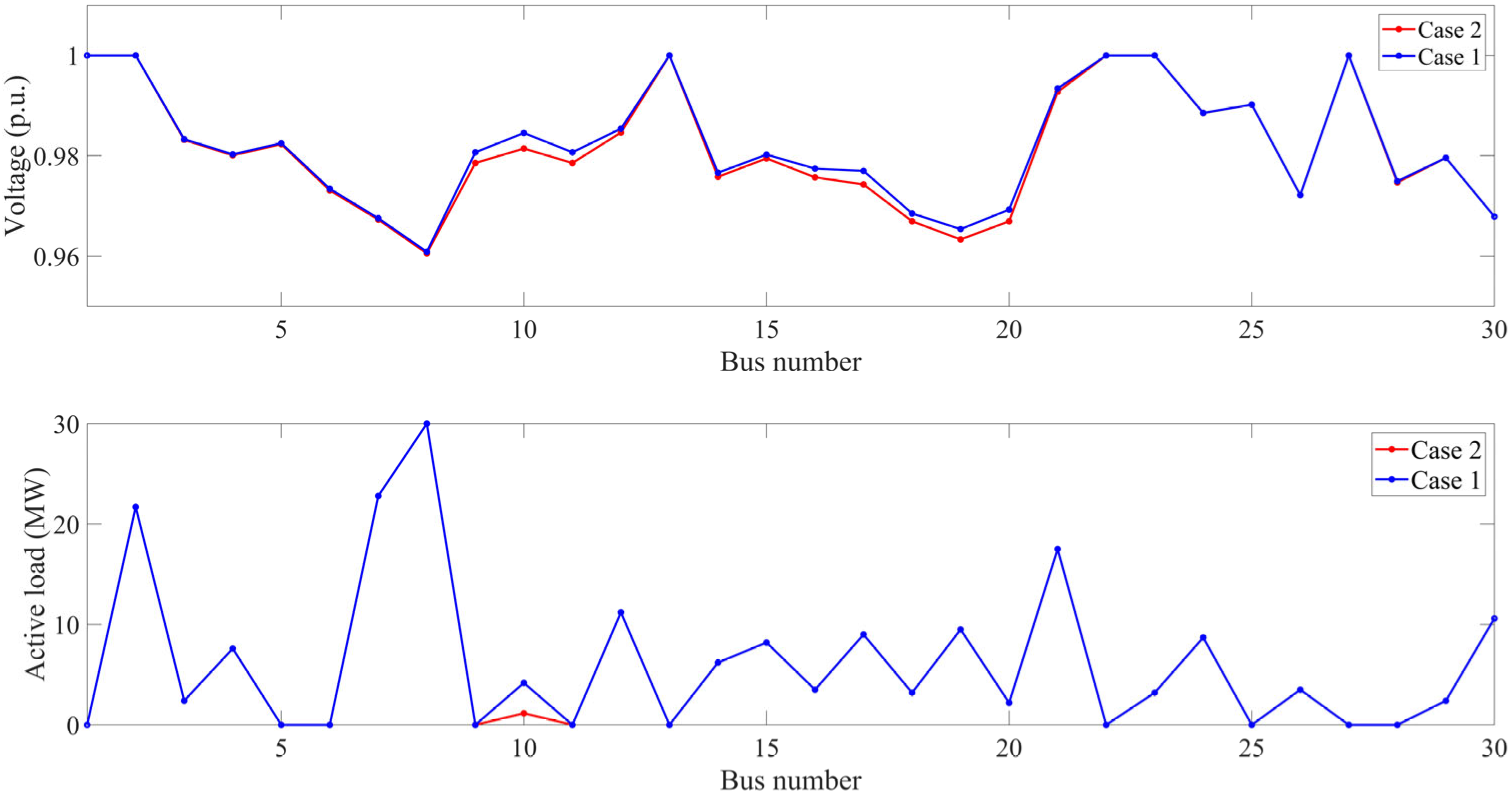
| References | Idea | Objectives | DERs Included | Test System |
|---|---|---|---|---|
| [29] | Impact of high penetration of small-scale DERs | Hosting capacity expansion, cost minimization, power loss minimization | Residential and small-scale commercial PV | Distribution grid |
| [31] | DERMS vs. line upgrade option to overcome problems of high penetration DER | Mitigate high voltage and large voltage fluctuations | PV and ESS | Distribution grid |
| [32] | Application of DERMS to aggregate reactive power from numerous small-scale air conditioners | Overcome transient over/under voltages | PV, EV charging stations, ESS | Distribution grid |
| [33] | A two-module DERMS platform by considering different electricity pricing policies | Minimizing operational costs of the MG | ESS and diesel generator | MG |
| [34] | Application of DERMS to curtail the most effective DERs to mitigate overloading | Minimizing DER power curtailment | - | Sub-transmission/distribution grids |
| [35] | Application of DERMS in the critical load restoration process and its coordination with DSO | Regulate frequency and voltage during restoration | PV, WT, ESS | Distribution grid |
| [37] | DERMS HIL test platform | Preventing reverse power flow at the substation during high DER generation | PV and ESS | Distribution grid |
| [36,38,39] | DERMS HIL test platform in the presence of hardware inverters | Voltage regulation | PV | Distribution grid |
| [40] | DERMS HIL test platform in the presence of grid-edge devices | Voltage regulation | PV | Distribution grid |
| [43] | DERMS HIL test platform in the presence of hardware inverters and local hardware controllers | Voltage regulation | PV | Distribution grid |
| [44] | DERMS HIL test platform to analyze cybersecurity aspects | - | ESS, PV, WT | Distribution grid |
| Reference | Objectives and Contributions | DERs Included | Test System |
|---|---|---|---|
| [46] | Minimizing operation costs, considering stochastic DERs, and bi-level formulation | PV, WT, microturbine | DN + MGs |
| [47] | Minimizing operation costs, considering two hierarchy levels, and energy exchange between MGs | ESS | DN + MGs |
| [48] | Minimizing fluctuations in power exchange, voltage deviations, and power losses in the distribution level Minimizing operation costs and air pollution in MG level | PV, WT, ESS | DN + clustered MGs |
| [49] | Voltage regulation, minimizing power loss and operational cost, and operational security of the network | PV, WT, ESS, soft open point (SOP) | DN + MGs |
| [50] | Minimizing cost and stress on the grid and maximizing PV utilization in the presence of EVs | PV, EVs | Charging station |
| [51] | Real-time load management system | PV, ESS | MG |
| Number | Concluded Gap | Subject Area |
|---|---|---|
| 1 | Application of utility DERMS and aggregator DERMS and their differences | DERMS |
| 2 | Neglecting the broad capability of DERMS and its numerous functions | DERMS |
| 3 | Neglecting the impact of DERs on transmission networks | Co-simulation of transmission and distribution networks |
| 4 | Neglecting DERMS in the simultaneous studies of transmission and distribution networks | DERMS and co-simulation of transmission and distribution networks |
| Type of Generation | Bus Number | Capacity (MVA) | Active Power Limits (MW) | Cost Coefficient | ||
|---|---|---|---|---|---|---|
| Min | Max | a | b | |||
| PV | 8 | 0.2 | 0 | 0.2 | - | - |
| 20 | 0.3 | 0 | 0.3 | - | - | |
| 24 | 0.2 | 0 | 0.2 | - | - | |
| DG | 12 | 4 | 0.5 | 4 | 28 | 92 |
| 22 | 2 | 0.5 | 2 | 31 | 110 | |
| WT | 18 | 3 | 0 | 3 | - | - |
| 30 | 2.1 | 0 | 2.1 | - | - | |
| DR decreased power | 32 | - | 0 | 0.63 | - | - |
| Source of Power | Bus Number | Outputs | Utilization (%) | |
|---|---|---|---|---|
| P (MW) | Q (MVAR) | |||
| Transmission system | 1 | 4.18 | 6.24 | - |
| PV | 8 | 0.2 | 0 | 100 |
| 20 | 0.3 | 0 | 100 | |
| 24 | 0.2 | 0 | 100 | |
| DG | 12 | 0.54 | 0.34 | 15.95 |
| 22 | 0 | 0 | 0 | |
| WT | 18 | 3 | 0 | 100 |
| 30 | 2.1 | 0 | 100 | |
| DR decreased power | 32 | 0 | 0 | 0 |
| Type of Generation | Bus Number | Outputs | Utilization (%) | |
|---|---|---|---|---|
| P (MW) | Q (MVAR) | |||
| Transmission system | 1 | 1.15 | 9 | - |
| PV | 8 | 0.2 | 0 | 100 |
| 20 | 0.3 | 0 | 100 | |
| 24 | 0.2 | 0 | 100 | |
| DG | 12 | 2.33 | −1.1 | 64.41 |
| 22 | 1.63 | −1.01 | 95.85 | |
| WT | 18 | 3 | 0 | 100 |
| 30 | 2.1 | 0 | 100 | |
| DR decreased power | 32 | 0.22 | 0.11 | 34.92 |
Disclaimer/Publisher’s Note: The statements, opinions and data contained in all publications are solely those of the individual author(s) and contributor(s) and not of MDPI and/or the editor(s). MDPI and/or the editor(s) disclaim responsibility for any injury to people or property resulting from any ideas, methods, instructions or products referred to in the content. |
© 2024 by the authors. Licensee MDPI, Basel, Switzerland. This article is an open access article distributed under the terms and conditions of the Creative Commons Attribution (CC BY) license (https://creativecommons.org/licenses/by/4.0/).
Share and Cite
Pourghasem Gavgani, P.; Baghbannovin, S.; Mohseni-Bonab, S.M.; Kamwa, I. Distributed Energy Resources Management System (DERMS) and Its Coordination with Transmission System: A Review and Co-Simulation. Energies 2024, 17, 1353. https://doi.org/10.3390/en17061353
Pourghasem Gavgani P, Baghbannovin S, Mohseni-Bonab SM, Kamwa I. Distributed Energy Resources Management System (DERMS) and Its Coordination with Transmission System: A Review and Co-Simulation. Energies. 2024; 17(6):1353. https://doi.org/10.3390/en17061353
Chicago/Turabian StylePourghasem Gavgani, Pouya, Salar Baghbannovin, Seyed Masoud Mohseni-Bonab, and Innocent Kamwa. 2024. "Distributed Energy Resources Management System (DERMS) and Its Coordination with Transmission System: A Review and Co-Simulation" Energies 17, no. 6: 1353. https://doi.org/10.3390/en17061353








